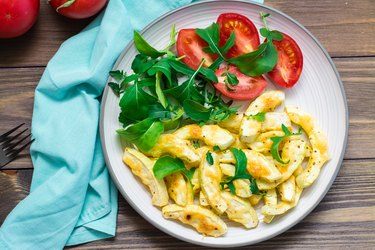
A homemade meal can be both comforting and delicious, but depending on the ingredients used, it may also be bloated with calories. Luckily, with some simple math and a food calorie calculator, it's easy to determine the caloric content of your favorite recipes.
Tip
To figure out the number of calories in a homemade dish, use a nutrition label calculator to add up the calories in each of the individual ingredients.
Video of the Day
Create a Spreadsheet
Figuring out the calories in the dishes you prepare is kind of like solving a simple math problem. While it may sound obvious, adding together the calories of each ingredient used will give you the total calories in the final dish. To help you do this, Tufts University suggests using a computerized spreadsheet.
Video of the Day
Start by dividing the sheet into three columns. In the first column, list each ingredient that goes into your recipe. The second column should include the amount of each ingredient that goes into the dish. Next, a nutrition label calculator can be used to look up the calories in each of the ingredients used, and these calories can be placed into the third and final column.
Read more: Low Calorie Diet & Headaches
The United States Department of Agriculture has compiled an extremely thorough nutrition label calculator that is free to use and contains many commonly found items for cooking or baking. If you cannot find a specific item, the Calorie Control Council also has a detailed recipe calorie calculator that can be helpful and includes even more frequently purchased grocery items.
Use a Recipe Calorie Calculator
Once you have used the food calorie calculator to find each of the individual ingredients in your dish, you can add up all of the calories in column three to get the total caloric content of the recipe. Organizing them in your spreadsheet should make it easy to total these numbers.
If you have trouble finding a specific food item in the recipe calorie calculator, take a closer look at the nutritional label. This will indicate the proper amount of calories for each food you are using.
Just be sure to convert the units of the amount used in your recipe to the proper quantity listed on the label as they may be in different units of measurement. When this happens, use an online conversion tool to easily switch between common measurement units and determine the calories in each food product.
By figuring out the total amount of calories in your dish, you'll better understand how your meal factors into your daily caloric intake. While the daily caloric recommendations for men vary from those for women, the Academy of Nutrition and Dietetics suggests that the average active adult consume between 2,400 and 3,000 calories per day.
Try Some Substitutes
After using your handy spreadsheet and recipe calorie calculator, you may have come to the unfortunate conclusion that there are a lot more calories in that delicious homemade meal than you realized. If this is the case, you may be able to lighten it up using a few simple substitutes without losing its flavor.
For example, the Mayo Clinic suggests using applesauce or prune puree in place of half of the amount of butter required in a recipe. Fat-free half-and-half or evaporated skim milk can also replace cream in many foods. Raw cocoa is a good substitute for milk chocolate, while Greek yogurt makes a healthy alternative to mayo and sour cream.
The amount of sugar in a dish can be halved and replaced with cinnamon or vanilla extract to decrease the calories but maintain its flavor and sweetness. Be sure to use your food calorie calculator to keep tabs on how much the caloric content changes when you make these easy switches!
- Tufts University: “Calculating Calories and Nutrients in Meals”
- United States Department of Agriculture: “FoodData Central”
- Calorie Control Council: “Food Calorie Calculator”
- Academy of Nutrition and Dietetics: “How Many Calories Do Adults Need?”
- Mayo Clinic: “Healthy Recipes: A Guide to Ingredient Substitutions”
- Calculators.org: "Cooking Conversion Calculator"
- USDA National Nutrient Database for Standard Reference